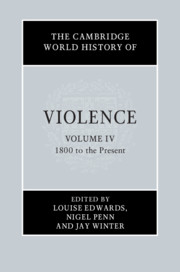Book contents
- The Cambridge World History of Violence
- The Cambridge History of Violence
- The Cambridge World History of Violence
- Copyright page
- Contents
- Figures and Maps
- Contributors to Volume IV
- Introduction to Volume IV
- Part I Race, Religion and Nationalism
- Part II Intimate and Gendered Violence
- Part III Warfare, Colonialism and Empire in the Modern World
- Part IV The State, Revolution and Social Change
- 17 Change and Continuity in Collective Violence in France, 1780–1880
- 18 Geographies of Genocide: The European Rimlands, 1912–1948
- 19 Concentration Camps
- 20 Violence in Revolutionary China, 1949–1963
- 21 Anti-Communist Violence in Indonesia, 1965–1966
- 22 The Violence of the Cold War
- 23 Quotidian Violence in the French Empire, 1890–1940
- 24 Violence, the State and Revolution in Latin America
- 25 Structural Violence during the Cambodian Genocide, 1975–1979
- 26 The Origins of Modern Terrorism
- Part V Representations and Constructions of Violence
- Index
- References
25 - Structural Violence during the Cambodian Genocide, 1975–1979
from Part IV - The State, Revolution and Social Change
Published online by Cambridge University Press: 13 March 2020
- The Cambridge World History of Violence
- The Cambridge History of Violence
- The Cambridge World History of Violence
- Copyright page
- Contents
- Figures and Maps
- Contributors to Volume IV
- Introduction to Volume IV
- Part I Race, Religion and Nationalism
- Part II Intimate and Gendered Violence
- Part III Warfare, Colonialism and Empire in the Modern World
- Part IV The State, Revolution and Social Change
- 17 Change and Continuity in Collective Violence in France, 1780–1880
- 18 Geographies of Genocide: The European Rimlands, 1912–1948
- 19 Concentration Camps
- 20 Violence in Revolutionary China, 1949–1963
- 21 Anti-Communist Violence in Indonesia, 1965–1966
- 22 The Violence of the Cold War
- 23 Quotidian Violence in the French Empire, 1890–1940
- 24 Violence, the State and Revolution in Latin America
- 25 Structural Violence during the Cambodian Genocide, 1975–1979
- 26 The Origins of Modern Terrorism
- Part V Representations and Constructions of Violence
- Index
- References
Summary
From its inception, the Communist Party of Kampuchea (better known as the Khmer Rouge) emerged as one of the most violent and brutal apparatus of state terror and murder since the Nazi party held power in Germany. Between April 1975 and January 1979, approximately 2 million people died from starvation, disease, exposure, torture, murder, and execution. The dominant interpretation of the Cambodian genocide presents the CPK as a totalitarian, communist, and autarkic regime seeking to reorganize Cambodian society around a primitive, agrarian political economy. From this vantage point, the victims of the regime perished because of misguided and irrational economic policies, a draconian security apparatus implemented to instill terror, and the central leadership’s fanatical belief in the creation of a utopian communist society. It is no so much that previous accounts are inaccurate as much as they are incomplete and theoretically vapid. To this end, I argue that CPK policy pivoted around surplus agricultural production and a selective engagement with the global economy as informed by its allegiance to the Non-Aligned Movement. Accordingly, I challenge the standard historiography of the Cambodian genocide by providing an analytical overview of the structures of violence set in place by the Khmer Rouge.
- Type
- Chapter
- Information
- The Cambridge World History of Violence , pp. 510 - 531Publisher: Cambridge University PressPrint publication year: 2020



